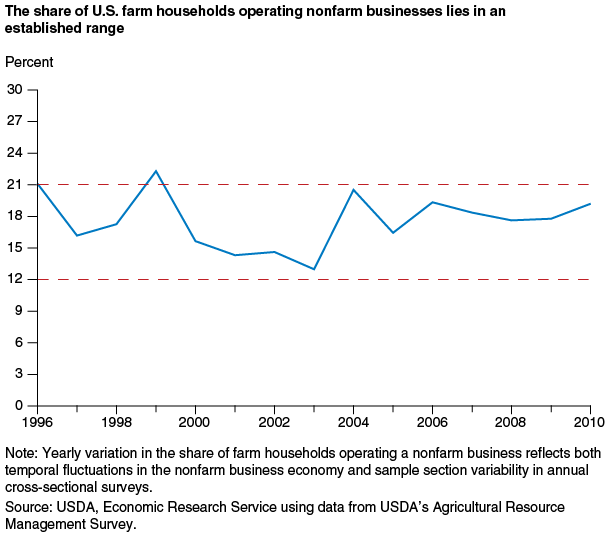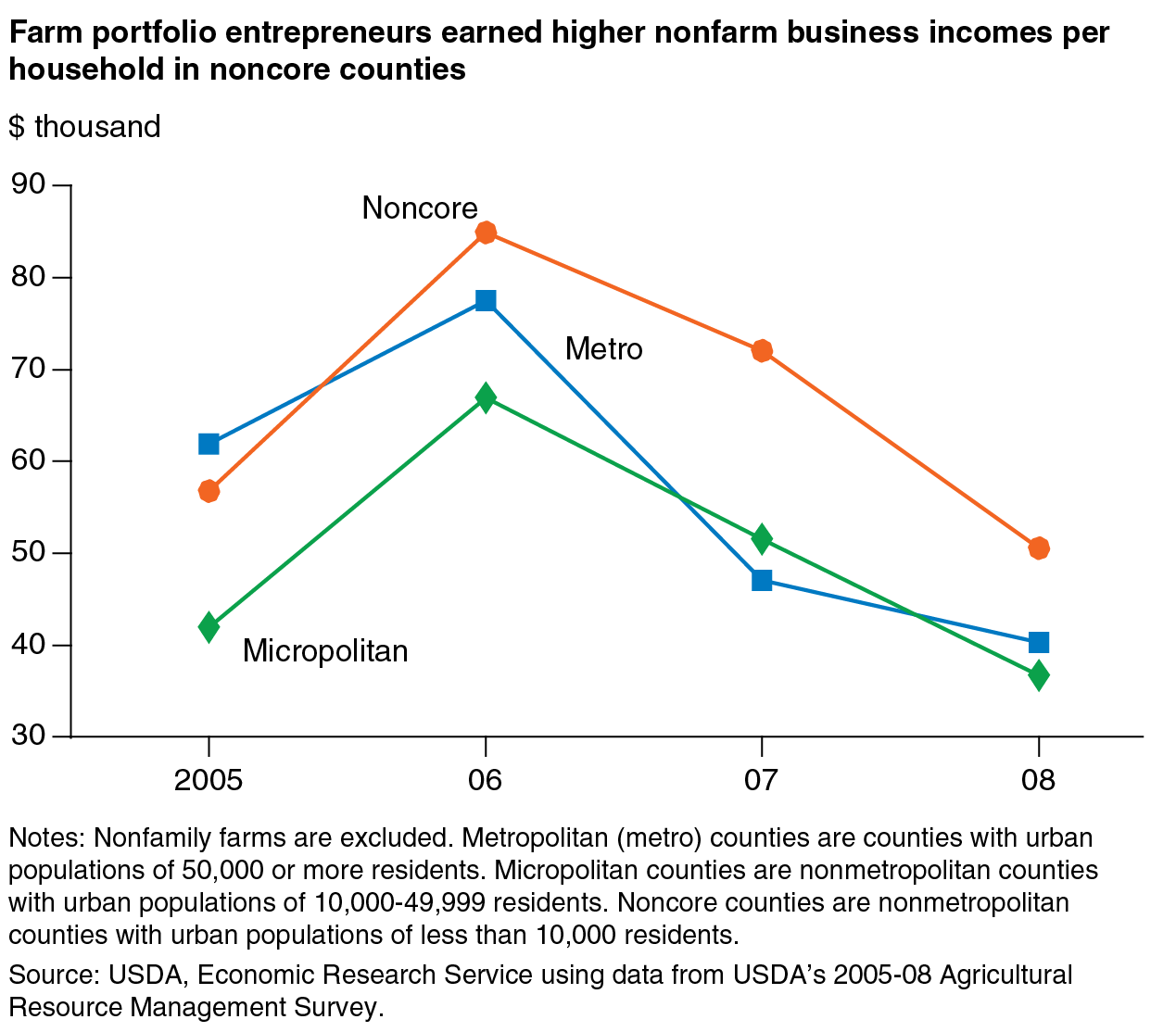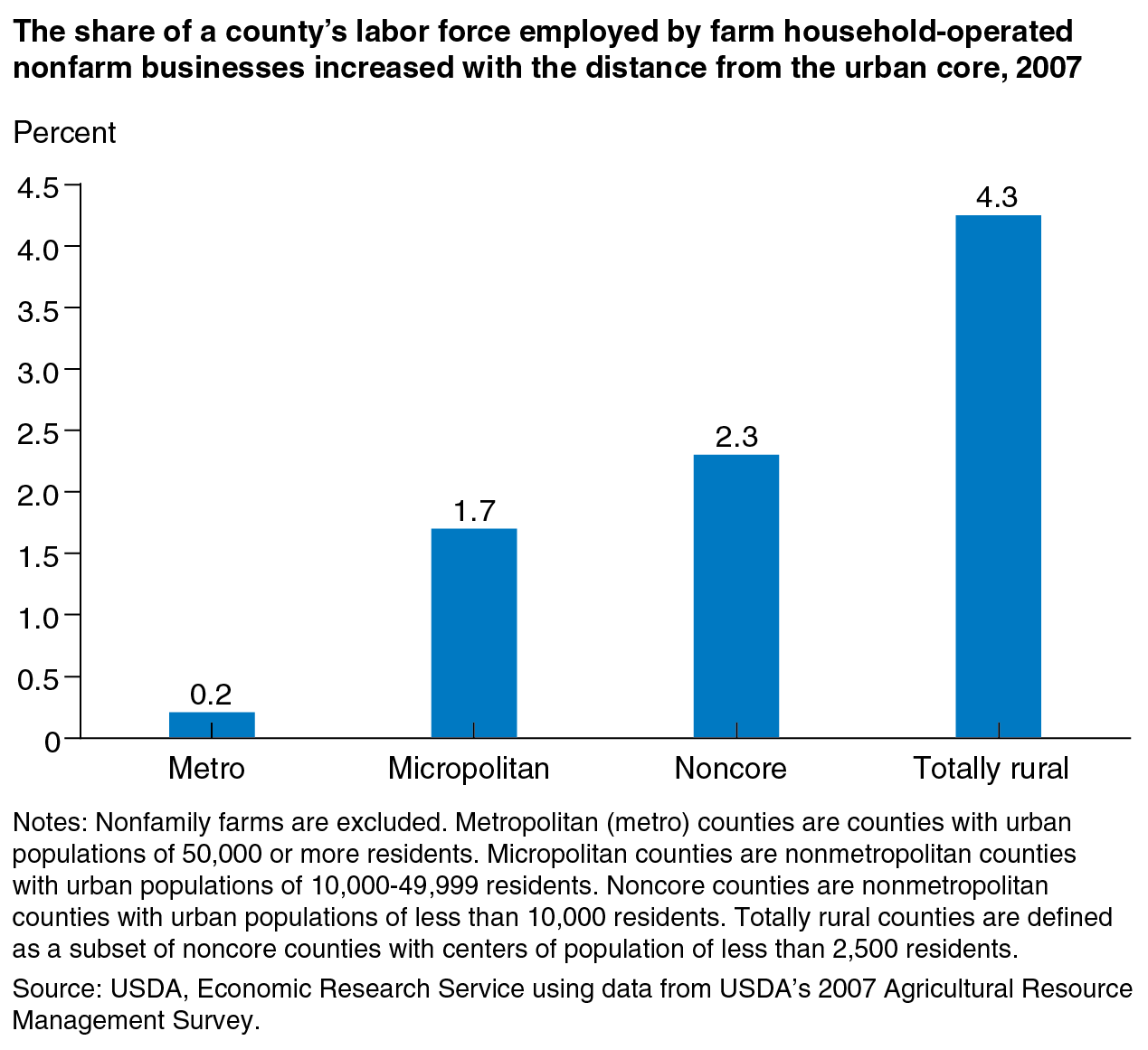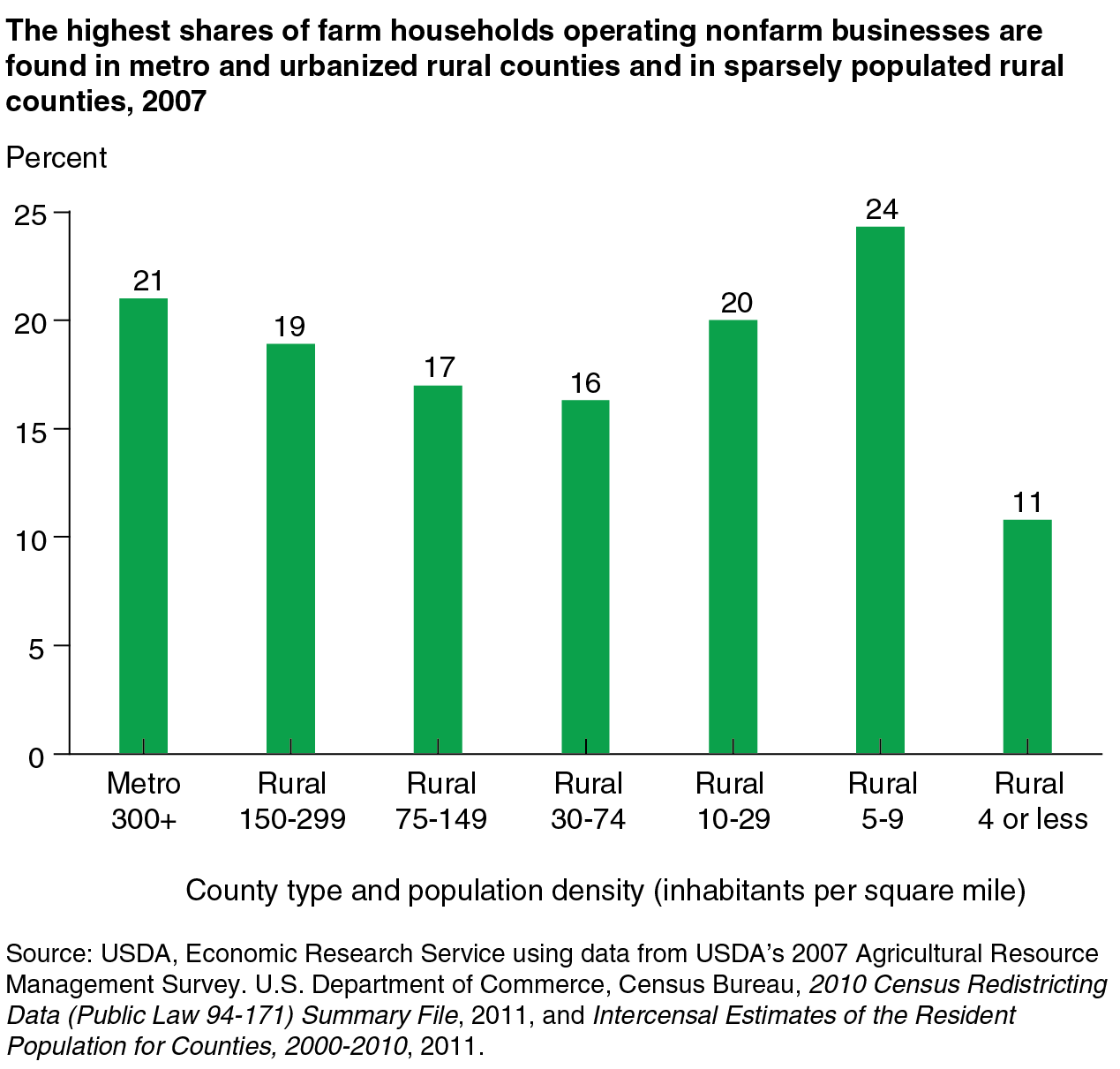The Importance of Farmer-Owned Nonfarm Businesses in the Rural Economy
- by Stephen Vogel
- 4/1/2013
Highlights
- Farm households that also operate nonfarm businesses have accounted for roughly 18 percent of U.S. farm households since the 1990s.
- Although households operating small farms account for most farmer-owned nonfarm businesses, households operating larger farms are nearly as likely to operate a nonfarm business.
- In 2007, farmer-owned nonfarm businesses employed over 800,000 nonfarm workers and contributed an estimated $55 billion to their local communities’ gross county product.
Farm operators and their households can use their entrepreneurial and managerial skills to earn business income in various ways. They can focus on traditional commodity production, use farm resources to produce both commodity and other farm-related goods and services (like agritourism or custom work for other farms), or operate a nonfarm business in addition to their farm enterprise. Farm households that operate both farm and nonfarm businesses simultaneously (referred to here as portfolio entrepreneurs) augment the local impacts of their farm operations by employing nonfarm labor and contributing to their communities’ gross county products through their nonfarm businesses.
Farm portfolio entrepreneurs represent a small but enduring share of the Nation’s farm household population. Based on data from USDA’s Agricultural Resource Management Survey (ARMS), almost 18 percent of U.S. farm households, on average, reported earning income from operating a separate nonfarm business over 1996-2010. Throughout this period, the shares of farm portfolio entrepreneurs among all U.S. farm households lay in the range reported in recent studies of portfolio entrepreneurs: 12 percent of operators of all types of small businesses (including farming) and 21 percent of all farm households when considered separately. Hence, the human capital skills unique to portfolio entrepreneurship may not be directly linked to farming but instead may represent attributes that farm portfolio entrepreneurs share with their nonfarm counterparts. Relative to other farm households, the comparative advantage of farm portfolio entrepreneurs--either by necessity or predilection--appears to be their ability to organize resources across multiple enterprises when new business opportunities arise.
Who are farm portfolio entrepreneurs?
About 395,600 farm households earned $21.6 billion in business income from operating one or more nonfarm businesses in 2007. The share of farm households operating nonfarm businesses ranged from nearly 14 percent of households operating commercial-size family farms to 19 percent of households operating small, rural residence farms (see box, “ERS Family Farm Categories”). Hence, portfolio entrepreneurs do not appear to be concentrated within a particular type of farm household. Nevertheless, rural residence farms accounted for 69 percent of portfolio-entrepreneur farms in 2007 and earned over 80 percent of total nonfarm business income reported by farm households that year--a disproportionate share of nonfarm business income relative to their numbers. On average, farm businesses operated by rural residence and commercial farm portfolio entrepreneurs had gross farm sales 23 to 34 percent higher than comparable farms operated by households that did not operate nonfarm businesses.
| Item | Rural residence | Intermediate | Commercial | All family farms |
|---|---|---|---|---|
| Total number of farm portfolio entrepreneurs | 274,688 | 92,793 | 28,102 | 395,583 |
| Percent of all farm households | 19.3 | 17.7 | 13.7 | 18.4 |
| Percent of farm portfolio entrepreneurs | 69.4 | 23.5 | 7.1 | 100.0 |
| Farm sales | ||||
| Average gross farm sales ($ per farm) | 14,790 | 38,113 | 1,169,616 | 103,419 |
| Gross farm sales ratio: portfolio entrepreneur farms to farms not operating nonfarm businesses | 1.23 | 0.58 | 1.34 | 1.04 |
| Nonfarm business income ($ million) | 17,748 | 2,333 | 1,538 | 21,619 |
| Percent of total reported by farm households | 82.1 | 10.8 | 7.1 | 100.0 |
| Nonfarm businesses by employer status | ||||
| Sole proprietorships (percent) | 59.1 | 74.9 | 59.9 | 62.8 |
| Employer establishments (percent) | 40.9 | 25.1 | 40.1 | 37.2 |
| Firm performance | ||||
| Average employer establishment income ($) | 122,581 | 60,401 | 72,583 | 108,886 |
| Nonfarm business income ratio: employer establishments to sole proprietorships | 5.0 | 4.5 | 1.7 | 4.8 |
| Total number of nonfarm jobs (1,000s) | 613.0 | 162.1 | 78.0 | 853.1 |
| Percent of total nonfarm jobs provided | 71.9 | 19.0 | 9.1 | 100.0 |
| Notes: Data exclude nonfamily farms. Nonfarm businesses not employing part-time or full-time workers are classified as sole proprietorships, while nonfarm businesses with employees are classified as employer establishments. Source: USDA, Economic Research Service using data from USDA’s 2007 Agricultural Resource Management Survey. |
||||
Why do farm households become portfolio entrepreneurs? Farm households with excess resources at their disposal may operate a second enterprise if land or other key inputs become too costly or unavailable or if nonfarm opportunities appear to be more profitable than intensive development of existing farm resources. For large commercial family farms with multiple operators, operating a nonfarm business can provide an income and career path for extended family members, ensuring that they remain part of the broader family farm business.
Contribution of farm portfolio entrepreneurs to the nonfarm economy
The economic footprint of farmer-operated nonfarm businesses can be measured by their contribution of value-added income to a local community’s gross county product. Defined as the sum of labor and capital income plus indirect business taxes, value-added income is a summary measure of the community’s economic activity. Farmer-operated nonfarm businesses contributed $54.6 billion in 2007 to their local communities’ gross county products. Without these contributions, the goods and services supplied by farmer-owned nonfarm businesses might have been imported from outside the local economy or might not have been available at all.
The economic impacts that farm portfolio entrepreneurs have on their local communities also depend on whether their nonfarm businesses employ workers from the nonfarm labor force. Nonfarm businesses with no employees are referred to here as sole proprietorships. Sole proprietorships include “mom-and-pop” businesses supplementing farm household income as well as startup enterprises with future business plans to hire nonfarm workers. Research findings suggest that small business enterprises with no employees often face fewer opportunities or possess limited financial or physical resources for enterprise growth, limiting their communitywide impacts as well as their household income prospects. In 2007, 62 percent of farm portfolio entrepreneurs were identified as sole proprietors, earning an average $22,600 in nonfarm business income per farm household.
Nonfarm businesses with employees are referred to here as employer establishments. Farmer-operated employer establishments are more likely to exemplify “growth entrepreneurs,” alert to new business opportunities, innovation, risk taking, and creative marshaling of resources. Although accounting for only 38 percent of all farmer-operated nonfarm businesses in 2007, these enterprises generated an average of $108,900 in business income per farm household, or five times the average nonfarm business income earned by farm households operating nonfarm sole proprietorships. Among all farmer-operated nonfarm businesses, employer establishments generated the largest local economywide impacts by contributing 87 percent of total farm portfolio entrepreneurial value-added income to their communities’ gross county products.
In 2007, farmer-operated nonfarm employer establishments employed 853,000 nonfarm workers in their local communities. Among all farm portfolio entrepreneurs, the more numerous rural residence farm households appear to have forged the strongest links to the nonfarm economy. In 2007, the nonfarm employer establishments of rural residence farm households generated $122,600 in business income per household--almost twice the average business income of other farmer-operated nonfarm employer establishments--and employed over 70 percent of all local nonfarm workers employed by farm portfolio entrepreneurs.
Among those farm portfolio entrepreneurs who reported the industrial sectors to which their nonfarm business belonged, 53 percent were in service sectors and 26 percent were in construction industries. In 2007, farmer-operated nonfarm businesses in service sectors generated $49.2 billion in sales and paid $14.1 billion in labor income to 408,600 workers. Operating with less physical capital and overhead relative to human capital, service-sector enterprises generated roughly 60 percent of all nonfarm business profit income accruing to farm households and almost 60 percent of all nonfarm labor income paid to their employees.
In many rural areas, local construction enterprises occupy a niche in which geographic distances reduce competition for local construction projects from more distant firms. Construction represents the second largest group of nonfarm businesses operated by farm households, suggesting that many farm operators use their mechanical and structural design skills in both their farm and nonfarm businesses. In 2007, farmer-operated nonfarm business enterprises in construction generated $32 billion in sales and paid out $6.2 billion in labor income to 182,500 workers.
Farmer-owned nonfarm businesses as crucial components of the rural economy
How important are nonfarm business income and nonfarm jobs generated by farm portfolio entrepreneurs to their local economies? It depends on the strength of the national economy and the nature of the local economy in which they operate. Farmer-owned nonfarm businesses are not immune to swings in the national economy. Based on survey data for 2005-08, business income earned by farm portfolio entrepreneurs expanded when the national economy was expanding and contracted as the recession took hold. While farm business income was largely unaffected by the recession, nonfarm business income was not.
The role that nonfarm business income plays in farm household finances and in local economies also depends on the location of the farm. This effect is examined using an urban/rural continuum that groups farmer-owned nonfarm enterprises by three types of counties: metropolitan (metro)—those with urban populations of 50,000 and above; nonmetropolitan-micropolitan (micropolitan)--those with urban populations of 10,000 up to 50,000; and nonmetropolitan-noncore (noncore)--those with urban centers of fewer than 10,000 residents.
Farm portfolio entrepreneurs in noncore counties earn, on average, higher business incomes than their counterparts in urban areas. From 2006 to 2008, average nonfarm business income per farm household located in noncore counties was about 30 percent higher than that earned by farm households in metro and micropolitan counties. This may suggest that the thin markets and geographic isolation characteristic of noncore counties may shield farm household-operated nonfarm businesses from outside competition.
Farmer-owned nonfarm businesses in more rural noncore communities also contribute to rural employment stability. The share of the employed labor force directly linked to farmer-operated nonfarm businesses is highest among those noncore counties with urban populations of fewer than 2,500 residents (defined here as totally rural counties). In 2007, jobs directly linked to farmer-owned nonfarm businesses accounted for 0.2 percent of the employed labor force in metro counties. For totally rural counties, nonfarm businesses operated by farm households employed 4.3 percent of the local employed labor force--roughly 20 times the relative contribution of farmer-owned nonfarm businesses in metro counties. On the surface, the share of the nonfarm labor force directly linked to farmer-operated employer establishments may appear to be small even in the totally rural counties. However, if these farmer-operated enterprises were to go out of business, the jobs indirectly linked to them would also be affected such that the total number of jobs lost in these counties could be far higher.
County-level population density captures one dimension of the geographic isolation of rural counties. Computed shares of farm portfolio entrepreneurs among all farmers grouped by county-level population densities indicate the extent to which market “thinness” may affect a farm household’s ability and willingness to operate a nonfarm business. The county-level percentages of farm households operating nonfarm businesses in 2007 follows a slight U-shaped curve as county population densities decrease from 300 inhabitants per square mile in metro counties to 5-9 inhabitants per square mile in rural counties. The high shares of farm households operating nonfarm businesses in metro and very urbanized nonmetro counties may suggest that farm households are presented with a plethora of nonfarm business opportunities in more urbanized economies--opportunities that may offset the urban pressures that can limit expansion of their farm operations. Twenty-one percent of farm households in metro counties operated a nonfarm business. In nonmetro counties, the share of farm households operating a nonfarm business declined to 16 percent in counties with a population density of 30-74 inhabitants per square mile, perhaps because entrepreneurial farm households faced fewer business opportunities.
Although rural counties with even lower population densities and smaller urban centers generate fewer business opportunities in increasingly thin markets, the corresponding local stock of entrepreneurial capital may be even lower once the population goes below a certain density, such that farm households can compete more effectively for existing business opportunities. Hence, the share of farm households operating nonfarm businesses rose to 20 percent in rural counties with population densities of 10-29 inhabitants per square mile and to 24 percent in rural counties with population densities of 5-9 inhabitants per square mile. However, once a county’s population density falls below the threshold of 5-9 inhabitants per square mile, entrepreneurial opportunities may become too scarce for many farm households wishing to develop nonfarm businesses. In the most sparsely populated counties (population densities of 4 or fewer inhabitants per square mile), only 11 percent of farm households operated a nonfarm business in 2007. The same U-shaped pattern of farm households engaged in nonfarm businesses over a minimum population density threshold was also observed in 2006, 2008, and 2009, based on ARMS data.
Over the years, ERS research has highlighted the diversity that characterizes farm households. Much of that diversity is also evident among farm portfolio entrepreneurs and their impact on their local economies. Just as the farms operated by farm households vary from small farms growing commodities for niche markets to large multimillion dollar farms serving international markets, the nonfarm businesses operated by farm portfolio entrepreneurs vary from small mom-and-pop ventures to firms employing 100 or more workers in some cases.
This article is drawn from:
- Vogel, S. (2012). Multi-Enterprising Farm Households: The Importance of Their Alternative Business Ventures in the Rural Economy. U.S. Department of Agriculture, Economic Research Service. EIB-101.
You may also like:
- ARMS Farm Financial and Crop Production Practices. (n.d.). U.S. Department of Agriculture, Economic Research Service.
- Farm Household Well-being. (n.d.). U.S. Department of Agriculture, Economic Research Service.





